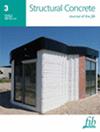Recent advances in embedded technologies and self‐sensing concrete for structural health monitoring
IF 3.3
3区 工程技术
Q2 CONSTRUCTION & BUILDING TECHNOLOGY
引用次数: 0
Abstract
Fully embedded and spatially diffuse sensors are central to the advancement of civil and construction engineering. Indeed, they serve as an enabling technology necessary for addressing the current challenges associated with through‐life management and structural health monitoring of existing structures and infrastructures. The need to identify structural issues early on has driven the integration of such embedded sensing capabilities into construction materials, turning passive structures into proactive, self‐aware “entities,” commonly referred to as Smart Structures. The economic rationale behind this endeavor is underscored by the vital significance of continuous monitoring, which enables prompt anomaly assessment and thus mitigates the risks of potential structural failures. This is particularly relevant for road and rail infrastructures, as they represent a substantial and enduring investment for any nation. Given that a large majority of these large infrastructures are composed of concrete and reinforced concrete, both academics and construction companies are continuously researching micro‐ and nano‐engineered self‐sensing solutions specifically tailored for this building material. This comprehensive review paper reports the latest advances in the field of self‐sensing concrete as of 2024, with an emphasis on intrinsic self‐sensing concrete, that is, electrically conductive functional fillers. A critical analysis and a discussion of the findings are provided. Based on the perceived existing gaps and demands from the industry, the field's future perspectives are also briefly outlined.用于结构健康监测的嵌入式技术和自感应混凝土的最新进展
完全嵌入式和空间扩散式传感器是土木建筑工程发展的核心。事实上,它们是解决目前与现有结构和基础设施的全寿命管理和结构健康监测相关的挑战所必需的使能技术。由于需要尽早发现结构问题,因此将这种嵌入式传感功能集成到建筑材料中,将被动结构转变为主动、自我感知的 "实体",通常称为智能结构。这种努力背后的经济理由突出表现在持续监测的重要意义上,它能够及时评估异常情况,从而降低潜在的结构故障风险。这一点与公路和铁路基础设施尤为相关,因为它们对任何国家来说都是巨大而持久的投资。鉴于这些大型基础设施大多由混凝土和钢筋混凝土组成,学术界和建筑公司都在不断研究专门针对这种建筑材料的微米和纳米工程自感应解决方案。这篇综合综述论文报告了截至 2024 年自感应混凝土领域的最新进展,重点是本征自感应混凝土,即导电功能填料。文章对研究结果进行了批判性分析和讨论。根据现有差距和行业需求,还简要概述了该领域的未来前景。
本文章由计算机程序翻译,如有差异,请以英文原文为准。
求助全文
约1分钟内获得全文
求助全文
来源期刊

Structural Concrete
CONSTRUCTION & BUILDING TECHNOLOGY-ENGINEERING, CIVIL
CiteScore
5.60
自引率
15.60%
发文量
284
审稿时长
3 months
期刊介绍:
Structural Concrete, the official journal of the fib, provides conceptual and procedural guidance in the field of concrete construction, and features peer-reviewed papers, keynote research and industry news covering all aspects of the design, construction, performance in service and demolition of concrete structures.
Main topics:
design, construction, performance in service, conservation (assessment, maintenance, strengthening) and demolition of concrete structures
research about the behaviour of concrete structures
development of design methods
fib Model Code
sustainability of concrete structures.
 求助内容:
求助内容: 应助结果提醒方式:
应助结果提醒方式:


